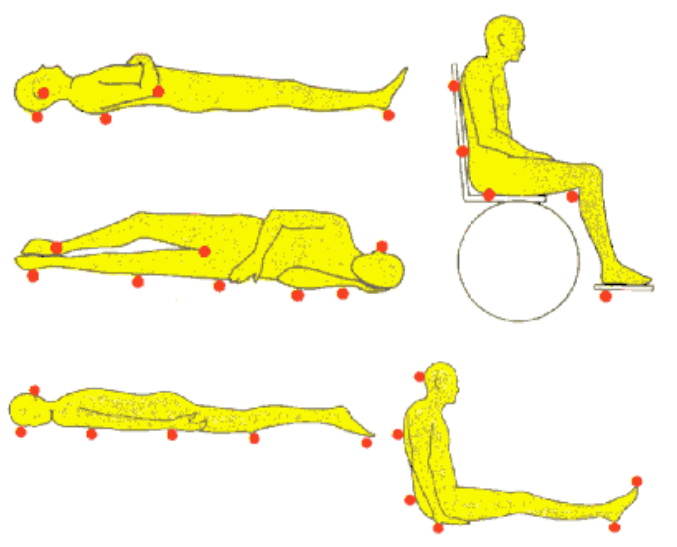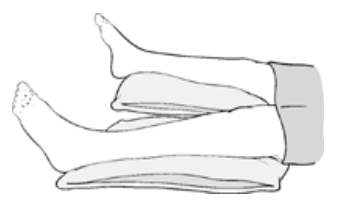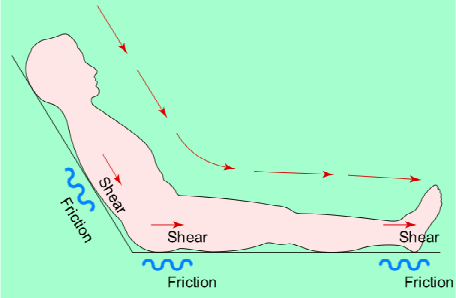Skin care for a child with limited mobility
Why is skin care important?
If your child is immobilized (unable to move freely) for any reason, pressure sores (ulcers) can occur. Too much pressure on the same area of skin for a long time can cause pressure sores.
What causes Pressure Sores?
Pressure causes a loss of blood flow and oxygen to the area, which can causes the skin and tissue cells to die. Proper skin care and pressure relief (weight shifts) can help prevent pressure sore
What are the signs of pressure sores?
Your child may have one or more of the following
- Skin redness that does not go away within 30 minutes after pressure is relieved
- Change in skin color or temperature (warmer or cooler than other skin areas nearby)
- Skin irritation such as a scraped area, break in the skin, blisters or sores
Where do pressure sores occur?
Pressure sores can occur in any area of the body, but boney areas are more likely than others to have problems. These include:
- Skull and ears
- Shoulders and shoulder blades
- Elbows
- Hips
- Lower back and tailbone
- Knees, shins
- Heels and ankles

How can I help reduce the risk of pressure sores for my child?
Your child's nurse or doctor may talk to you about specific care for your child. Some general guidelines are:
Skin care
- Check your child's skin often for any of the symptoms listed – especially in the boney areas and skin folds
- Keep your child's skin clean and dry
- Use lotions to prevent dry skin
- Avoid tight fitting clothes that may rub against your child's skin
- Keep bed linens dry – use changeable pads as needed
- Watch for wrinkles in linens and cloths that may cause pressure in one area
- Protect boney areas from pressure
Movement
- Children usually move every 15 minutes. When your child is in bed, have them turn at least every 2 hours while awake and every 4 during the night.
- Use a schedule to turn your child if they are unable to turn themselves.
- Do weight shifts at lest every 15-30 minutes when up in a chair.
Pressure reduction
- Use pressure re-distribution surfaces such as cushions, special mattresses and padding to support boney area.

- Avoid donut type devices which may increase pressure in some area (toilet seat time should be < 15 minutes)
- When you move or reposition your child, avoid friction that can pull and "shear" skin.

Other help
- Give your child a healthy diet and plenty of fluids. Good nutrition helps keeps skin healthy.
- Teens should avoid smoking and alcohol; these can decrease circulation to the skin and cause a greater risk of skin problems.
When should I call the doctor?
- You notice any type of skin redness or discoloration that lasts > 30 minutes after you change positions.
- You notice new signs of skin irritation such as rashes, sores, blisters, bruises
- You have questions or concerns about skin care and treatment
What else do I need to know?
- There is more risk for skin problems if your child has a loss of feeling in part of his body.
- Avoid having IV lines placed in areas with decreased feeling. They have decreased circulation and your child will not be able to feel irritation, burning or pressure if the catheter becomes displaced.
- Be careful with hot liquids.
- Avoid heating pads, electric blankets or other types of heat to parts of the body with less feeling.
- Protect skin from extremes of weather temperature if there is decreased feeling.
Questions?
This sheet is not specific to your child, but provides general information. If you have any questions, please call your clinic.
References:
- American Academy of Pediatrics (AAP)
- Institute for Healthcare Improvement (IHI)
- "Million Lives Campaign"
- Child Health Corporation of America (CHCA)
- National Institute for Children's Healthcare Quality ( NICHQ)
- National Association of Children's Hospitals and Related Institutions (NACHRI)
Children's Hospitals and Clinics of Minnesota
Patient/Family Education
2525 Chicago Avenue South
Minneapolis, MN 55404
Reviewed by S. Oehlke 7/2015 © Copyright
This page is not specific to your child, but provides general information on the topic above. If you have any questions, please call your clinic. For more reading material about this and other health topics, please call or visit Children's Minnesota Family Resource Center library, or visit www.childrensmn.org/educationmaterials.
© 2024 Children's Minnesota
